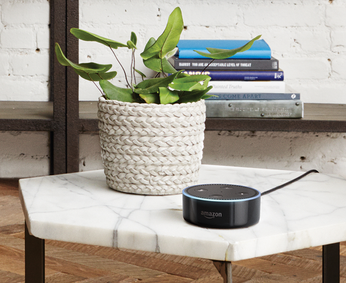Programming Snapshot – Alexa
Equipping Alexa with self-programmed skills

Asking Alexa only for built-in functions like the weather report gets old quickly, and add-on skills from the skills store only go so far. With a few lines of code, Mike teaches this digital pet some new tricks.
Okay, I admit, I don't like getting up from the sofa to check out something on the Internet if my phone is out of reach. But who does? In the household of the future, a device like Amazon's Echo will be around to help you with things like this in the form of a tin can in the living room. The Amazon Echo Dot, which looks much like a hockey puck (Figure 1), is the successor to the tin-can-like Echo device and offers the same voice interface at a lower price point.
Amazon's dream, of course, might be that customers at home will just shout "Alexa, order toilet paper," to send the language assistant scurrying off to place the order with the Internet discounter, who then quickly dispatches a drone to deliver the much-needed household item to the anxiously waiting consumer.
[...]
Buy this article as PDF
(incl. VAT)
Buy Linux Magazine
Subscribe to our Linux Newsletters
Find Linux and Open Source Jobs
Subscribe to our ADMIN Newsletters
Support Our Work
Linux Magazine content is made possible with support from readers like you. Please consider contributing when you’ve found an article to be beneficial.

News
-
Another Linux Malware Discovered
Russian hackers use Hyper-V to hide malware within Linux virtual machines.
-
TUXEDO Computers Announces a New InfinityBook
TUXEDO Computers is at it again with a new InfinityBook that will meet your professional and gaming needs.
-
SUSE Dives into the Agentic AI Pool
SUSE becomes the first open source company to adopt agentic AI with SUSE Enterprise Linux 16.
-
Linux Now Runs Most Windows Games
The latest data shows that nearly 90 percent of Windows games can be played on Linux.
-
Fedora 43 Has Finally Landed
The Fedora Linux developers have announced their latest release, Fedora 43.
-
KDE Unleashes Plasma 6.5
The Plasma 6.5 desktop environment is now available with new features, improvements, and the usual bug fixes.
-
Xubuntu Site Possibly Hacked
It appears that the Xubuntu site was hacked and briefly served up a malicious ZIP file from its download page.
-
LMDE 7 Now Available
Linux Mint Debian Edition, version 7, has been officially released and is based on upstream Debian.
-
Linux Kernel 6.16 Reaches EOL
Linux kernel 6.16 has reached its end of life, which means you'll need to upgrade to the next stable release, Linux kernel 6.17.
-
Amazon Ditches Android for a Linux-Based OS
Amazon has migrated from Android to the Linux-based Vega OS for its Fire TV.


